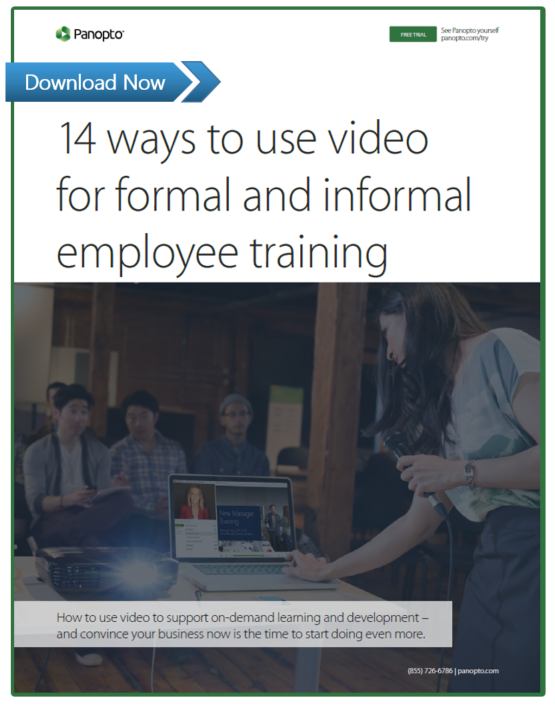- Social Learning & Knowledge Management
5 Opportunities to Embrace Informal Learning with Video
Today, “training video” is simply too generic a term.
In modern corporate training environments, video plays a variety of roles, from standardizing onboarding processes and providing live product demonstrations to fostering social learning and coaching by subject matter experts. Learning and development teams around the world have already begun to implement video in numerous ways.
Just as important as the sheer volume of video training options, however, is where some of those videos are coming from. While many of the innovative ideas in use today come from experienced trainers, a new wealth of others are coming from an organization’s employees themselves.
“Social Learning” and other grassroots strategies for sharing institutional expertise aren’t particularly new — employees have been turning to internal subject matter experts for quick answers since time immemorial. But often these Q&A sessions were one-offs — impossible for others to take advantage of if they weren’t already nearby.
Video, however, changes all of that.
With video, employees can easily record and share their knowledge, exchange insights, and learn from each other.
A new wave of research suggests social learning may, in fact, be one of the most effective ways for organizations to educate employees. So just how are organizations embracing this informal learning? Let’s take a look at some of today’s latest trends and evolving strategies.
1. Capture and share institutional knowledge
In today’s businesses, virtually everyone is a subject matter expert in something. Whether it’s how product architecture is drawn, how individual teams manage data, how leads are processed through CRM systems, or how the supply chain is organized, someone on your team knows the intricate details of how each and every part of your business actually works.
That offers quite an opportunity — and a big potential problem. If you haven’t captured that knowledge, it literally walks out the door with your employees. The average business loses 12% of its workforce annually — those that haven’t documented their institutional knowledge may wake up to find it’s gone to work for the competition, and no one left has the answers.
Video meets this potential crisis with a single solution — and two exceptional benefits.
First, asking your subject matter experts to record their expertise is an easy way to document and share all those details that make up the daily operations at your company, ensuring that vital information never walks out the door.
And second, even if your experts never leave, video can also be an effective tool for you to help them more effectively manage their time. Rather than explaining the same processes and programs over and over whenever the question comes up, sharing a link to a previously-recorded answer will save their time for new and more pressing work, while still ensuring the questioner gets the information they needed.
Small wonder that according to a study from Bersin by Deloitte, the average enterprise is spending three times more on social learning tools than in the previous two years.
See an example of how employees share knowledge through video below:
2. Role play with video
Ultimately, much of an organization’s success lies simply in the way employees interact with customers and each other. Many businesses have invested lavishly in this area, scripting interactions, templating communications, hoping to standardize how the company presents itself — both inwardly and outwardly.
But human beings are visual animals, highly tuned to social cues. Non-verbal elements famously comprise some 90 percent of our communications. 
Scripts, manuals, and other printed handbooks simply don’t cut it. But video-enabled role-playing does.
Video role-playing can run the gamut of formal to informal training. Many organizations are finding that simply recording their star employees in action can help to identify behavioral traits and actions that help them succeed.
As an engaging, visual medium, video conveys the style and delivery, not just the substance, of a targeted interaction. Nuances in tone of voice, body movement and other nonverbal cues are communicated, helping new and experienced employees alike succeed in their roles.
Just a few of the examples of customer interaction training videos that employees can role-play and record with little more than a webcam and their laptop:
- Understanding the buyer reenactments
- Phone and in-person sales engagements
- Sales and marketing presentations
- Front-line employee-customer interactions
And with an easy-to-use video content creation tool, any time an employee discovers a new best practice relating to their role, he or she can share it with the entire team by just pressing “record.”
3. Provide video-enabled coaching
You may already have the best training program in the business. You may already share more information than anyone else, with test scores showing your team is genuinely learning every last detail. But it’s all for naught if your employees aren’t putting that knowledge to use when they need to.
From telemarketers and customer service reps to new managers and even professional athletes, there’s no shortage of evidence that recording and reviewing one’s performance with a coach can be a quick and effective way to diagnose issues and identify opportunities for improvement.
Recording key employee activities for review can help professional coaches actually see where an employee is working at their best, and show employees exactly where and how they may be getting off track. Here video can serve as an objective witness, helping a coach to play back specific moments and offer feedback.
In this way, salespeople can find ways to improve their effectiveness, front-line workers become more aware of the impression they’re making — even managers learn to communicate more effectively. A simple way to help people see themselves in action, video allows employees, including company leaders, to more easily identify their weak spots, then practice improving upon them until they get it right.
4. Capture knowledge shared in meetings
While formal training frequently echoes the classroom — with a designated teacher and a planned learning objective — some of the most common internal learning happens instead almost incidentally. Often this “training” isn’t training at all, but a piece of information shared as part of a discussion that may shape how an individual or team approaches its work.
The information shared in meetings at most organizations can vary widely, from facts about a given project, to more open-ended concepts like organizational priorities and processes. This information can be enormously valuable as a reference for future meetings, as review material for employees who couldn’t attend in person, as part of the onboarding process for new hires, and for driving understanding and alignment with other teams across the organization.
Recording meeting videos creates a useful record of the hows and whys of past decisions, the ideas that were brainstormed, and the insights exchanged. Without the video, this valuable information is often lost shortly after the meeting wraps up.
With meeting recordings, however, all the insights, decisions, and other important bits of information can be recalled anytime from any device. The team can return to the initial discussion to find all those ideas that haven’t yet been implemented and the insights they may have forgotten.
This is why a growing number of organizations are making meeting recording a part of regular business rhythm. These recording often include:
- Project kickoff discussions
- Status update calls
- Engineering sprint reviews and retrospectives
- Business scorecard reviews
And meetings don’t have to be recorded in their entirety for organizations to see value. Video can also be a quick way to provide a meeting summary and next steps, without requiring all the extra time involved to write a formal follow-up email.
5. Capture knowledge shared in deliverable reviews
In her report, Informal Learning Garners Acceptance As A Legitimate Learning Approach, Forrester Research Analyst Claire Schooley contends: “Informal learning creates work environments where employees take responsibility for their own learning, aided by employers that provide easy access to the appropriate content and tools. Social learning, in which people learn from each other, is a subset of informal learning.”
Meetings are certainly one key source of informal knowledge sharing. But there is another source of informal teaching – one that most organizations rely on to teach processes and quality expectations — deliverable reviews. These interactions are often little more than a manager sending an email or swinging by an employee’s desk with a pen in hand, making a few notes on the document, deck, or other deliverable, and offering ideas for improvement.
But while the interaction seems small, the opportunity for learning is significant.
Deliverable reviews teach employees the right way to create documents and other forms of communication that adhere to an organization’s standards. They teach format, structure, and content. They impart design expectations. They help employees come to know how the organization makes a case for change, shares data, delivers updates, and virtually every other aspect of getting work done.
Yet for all that value, the typical review is done in the moment — beneficial only to the employee who received it, and generally impossible to reference later. And even when feedback is written, it’s often a painstaking task of tracked changes (which still isn’t possible for every document format), coupled with bullet after bullet of written feedback.
Video output reviews offer an alternative.
With video, a reviewer can record the deliverable on their screen, as well as their onboard laptop webcam to capture their spoken feedback. Together, the recording can show what changes were made, specifically where the reviewer had feedback, and how the reviewer would like to see a new version modified — with minimal chance for miscommunication.
And because video can be saved and shared, a manager can provide recorded deliverable reviews to new team members as needed, giving that new person a real-world example of how to take on the task while saving the manager the time that would otherwise be required to repeat the information.
Watch an example deliverable review video below:
 Learn More About Supporting Informal Learning With Video
Learn More About Supporting Informal Learning With Video
In our latest white paper, 14 Wasys To Use Video For Formal and Informal Training, we help L&D practitioners make the business case for doing more with video, including:
- 5 benefits that help convince your decision makers to use video in more ways for L&D
- 14 ideas for supporting and scaling formal and informal learning with video
- 1 technology — the video platform — that simplifies the use of video for L&D
Today’s learning and development professionals already understand the potential that video technology offers. Make sure your organization isn’t missing out!


